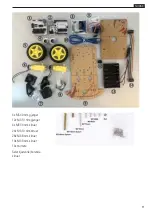
2
ENGLISH
What is Arduino?
Arduino is an open-source electronics platform based on easy-to-use hardware and software. Arduino
boards can read inputs - light on a sensor, a finger on a button, or a Twitter message - and turn it into an
output - activating a motor, turning on an LED, publishing something online. You can tell your board what
to do by sending a set of instructions to the microcontroller on the board. To do so you use the Arduino
programming language (based on Wiring), and the Arduino Software (IDE), based on Processing.
What is UNO?
The Uno is on the ATmega328. It has 14 digital input/output pins (of which 6 can be used as PWM outputs),
6 analogue inputs, a 16 MHz ceramic resonator, a USB connection, a power jack, an ICSP header, and a
reset button.
It contains everything needed to support the microcontroller; simply connect it to a computer with a USB
cable or power it with a AC-to-DC adapter or battery to get started.
Software
Connect your UNO board with your computer. Connecting UNO and your PC by a blue USB cable, and if
connected correctly you will see the green power LED light up and another orange LED is blinking.
We need to figure out which channel COM is currently communicating between PC and UNO. Following the
path: Control panel | Hardware and Sound | Devices and Printers | Device Manager | Ports (COM & LPT) |
Arduino UNO (COMx).
See the picture on the next page. Find your Serial COM number and write it down as the COM port may vary
from time to time. In this case for demonstration purposes we're using COM 4.



































